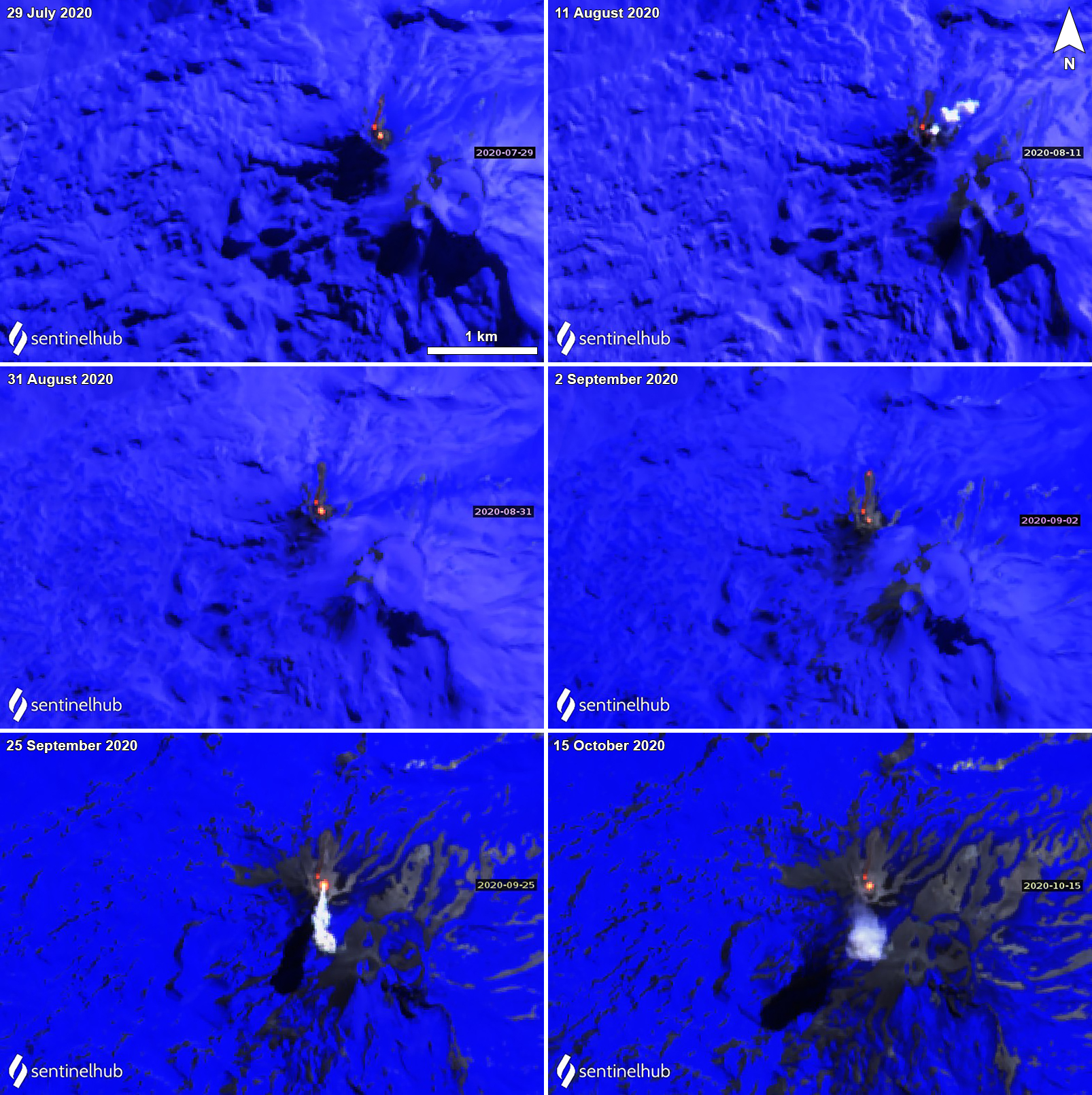Report on Nevados de Chillan (Chile) — November 2020
Bulletin of the Global Volcanism Network, vol. 45, no. 11 (November 2020)
Managing Editor: Edward Venzke.
Edited by Kadie L. Bennis.
Nevados de Chillan (Chile) Frequent explosions, a lava flow on the N flank, and lava dome growth during July-October 2020
Please cite this report as:
Global Volcanism Program, 2020. Report on Nevados de Chillan (Chile) (Bennis, K.L., and Venzke, E., eds.). Bulletin of the Global Volcanism Network, 45:11. Smithsonian Institution. https://doi.org/10.5479/si.GVP.BGVN202011-357070
Nevados de Chillan
Chile
36.868°S, 71.378°W; summit elev. 3180 m
All times are local (unless otherwise noted)
Nevados de Chillán, located in the Chilean Central Andes, is a volcanic complex composed of late-Pleistocene to Holocene stratovolcanoes. On 8 January 2016 an explosion created the Nicanor Crater on the NW flank of Volcán Viejo. Recent activity consists of explosions, ash plumes, pyroclastic flows, and a new lava dome in the Nicanor Crater (BGVN 45:07). This report covers July through October 2020; activity is characterized by frequent explosions, ash plumes, a lava flow on the N flank, and continued lava dome growth. The primary source of information comes from the Servicio Nacional de Geología y Minería (SERNAGEOMIN)-Observatorio Volcanológico de Los Andes del Sur (OVDAS), the Buenos Aires Volcanic Ash Advisory Center (VAAC), and satellite data.
Since 27 June webcams have showed an active lava flow that originated from the Nicanor Crater and descended the N flank. Activity during July consisted of 210-473 volcano-tectonic seismic events and 565-614 explosive events. Ash plumes rising 1.1-1.2 km above the crater and were accompanied by day and nighttime incandescence on the E edge of the Nicanor Crater. Due to these explosions, SERNAGEOMIN reported that tephra and other pyroclastic deposits were deposited within 400 m to the E of the crater. On 1 July a Buenos Aires VAAC advisory reported that a webcam showed ash emissions rising to 4.3 km altitude. Continuous explosions the next day produced ash plumes that rose 500 m above the crater. During 1-2 July the active lava flow had reached 40 m long and descended at a rate of 0.2 m3 per second. On 6 July an explosion at 0837 generated a gas-and-ash plume that rose 1.2 km above the crater and drifted SE; sporadic ash emissions were also observed on 7 July, according to a VAAC advisory. SERNAGEOMIN webcams showed that the lava flow that began on 27 June continued down the N flank, while a new lobe 55-194 m long moved toward the NE flank of Nicanor Crater. Gas plumes were also observed rising above the active crater, as noted on 20 July (figure 63). On 29 July weak ash emissions rose 3.9 km altitude and drifted SE, according to a VAAC report. During that day, the volume of the lava dome measured 400,000 m3 and grew at a rate of 0.1 m3 per second. Throughout the month, the lava flow continued to descend the N flank of the Nicanor Crater, reaching 520 m at a rate of 0.7-0.6 m per hour. Some unconsolidated blocks up to a meter in size detached from the front of the flow and moved up to 240 m. Sulfur dioxide emissions during the month averaged 823 tons/day with a high value of 1,815 tons/day reported on 29 July.
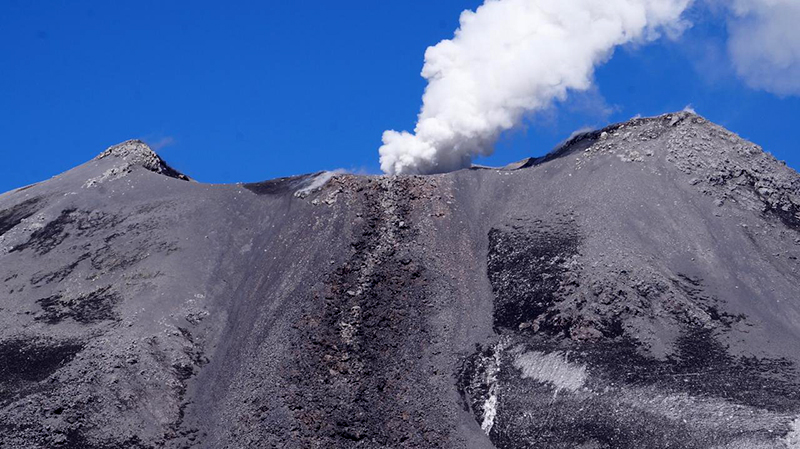 |
Figure 63. A white gas-and-steam plume was observed at Nevados de Chillán on 20 July 2020. Courtesy of SERNAGEOMIN webcam, posted by Volcanology Chile. |
During August SERNAGEOMIN reported 68-75 volcano-tectonic seismic events and 497-578 explosive events, the latter of which ejected material as far as 300 m E and NE from Nicanor Crater. Associated ash plumes rose 800-980 m above the crater and were accompanied by day and nighttime crater incandescence. The lava dome continued to grow during the month, reaching a thickness of 41 m, according to SERNAGEOMIN. SO2 emissions were an average value of 134-205 tons/day with a high value of 245 tons/day reported on 3 August. On 15 August a VAAC advisory reported weak and sporadic gas-and-ash emissions at the summit; on 20 August a hotspot was detected in satellite imagery, though an ash plume was not observed. The active lava flow on the N flank extended 490-495 m and moved at a rate of 0.07-0.06 m per hour. On 31 August a webcam showed an ash plume rising above the volcano, accompanied by the advancing lava flow on the N flank (figure 64).
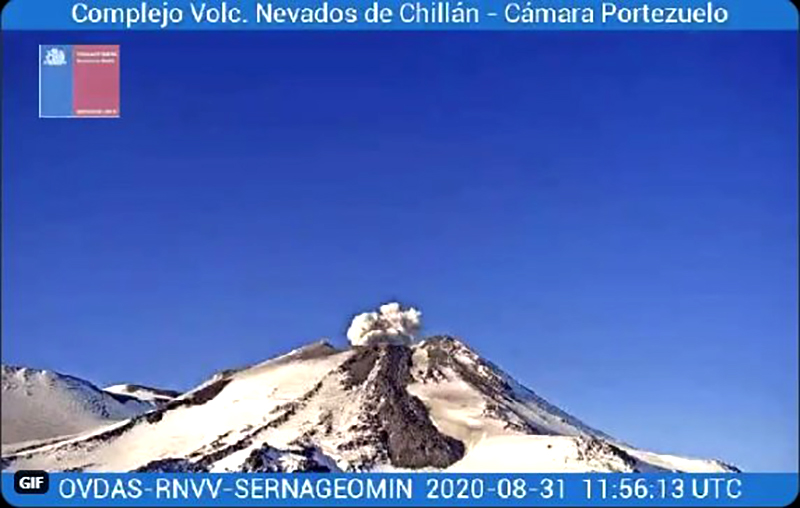 |
Figure 64. An explosion at Nevados de Chillán produced an ash plume on 31 August 2020. A lava flow accompanies the ash plume on the N flank. Courtesy of SERNAGEOMIN. |
Similar activity continued into September, with 45-48 volcano-tectonic and 591-621 explosive events. Ash plumes rose to 1.5 km above the crater and were accompanied by day and nighttime incandescence on the E edge of Nicanor Crater. During 1-15 September explosions at the lava dome produced ash plumes that rose to less than 1.5 km altitude, resulting in ashfall within 300 m E and NE of the crater; ejecta from larger explosions was also observed to the ESE. Satellite images showed partial destruction of the lava dome as well as loss of some material due to successive explosions at the beginning of the month. Overall, the dome continued to increase in size, reaching a volume of 180,000 m3 and a thickness of 45 m since August (41 m). The lava dome measured 93 m NW-SE and 104 m SW-NE. By 15 September the 500-m-long lava flow had descended the NNE flank and continued to advance at a rate of 1.7 m per hour. The W levee of the flow channel had ruptured, which caused the toe of the lava flow to thicken. On 20 September ash emissions rose to 3.7 km altitude and drifted NE and ENE, according to a VAAC advisory. On 22 September gas emissions, weak and sporadic ash emissions, and occasional explosions accompanied the lava flow. Through the remainder of the month, the lava flow persisted, measuring 615 m, and advancing at a rate of 0.4 m per hour; its volume was 487,000 m3 (figure 65). SO2 emissions were an average value of 111-358 tons/day with a high value of 503 tons/day reported on 22 September.
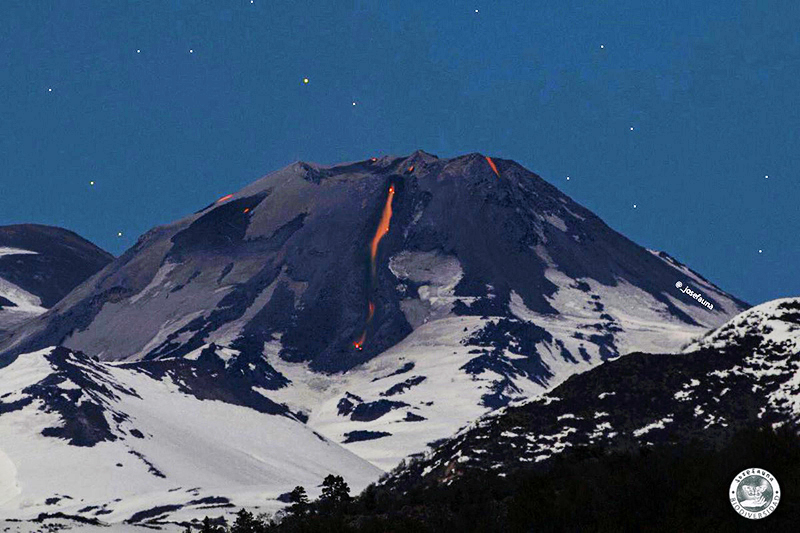 |
Figure 65. Photo (color corrected) of the incandescent lava flow at night descending the NNE flank of Nevados de Chillán on 21 September 2020. Photo by Jose Fauna, courtesy of Volcanology Chile. |
During October there were 34-61 volcano-tectonic seismic events reported, as well as 607-644 explosive events, seven of which generated ash plumes that rose 1-1.5 km above the crater. Day and nighttime incandescence in the E edge of Nicanor Crater remained. Ash deposits associated with the explosive activity were distributed to the E and NE as far as 300 m from the crater; denser pyroclastic deposits from stronger explosions were located to the N and NE. The lava flow on the N slope persisted, extending 614-683 m from the crater rim at a rate of 0.1-0.82 m per hour with a width of 80.2 m near the crater rim and up to 112.8 m near the toe. The lava dome also continued to grow since it was last measured in September; it was 115 m wide at the base by 107 m high. SO2 emissions were an average value of 167-355 tons/day with a high value of 588 tons/day reported on 26 October. On 29 October an ash plume was detected in satellite imagery and rose to 3.7 km altitude and drifted W, according to a VAAC advisory (figure 66). SERNAGEOMIN reported that a 25-m-diameter subcrater had formed on the E inner edge of Nicanor Crater at the top of the lava dome. On 30 October, intermittent gas-and-ash emissions were visible at the summit in satellite imagery, rising to 3.9 km altitude and drifting SE.
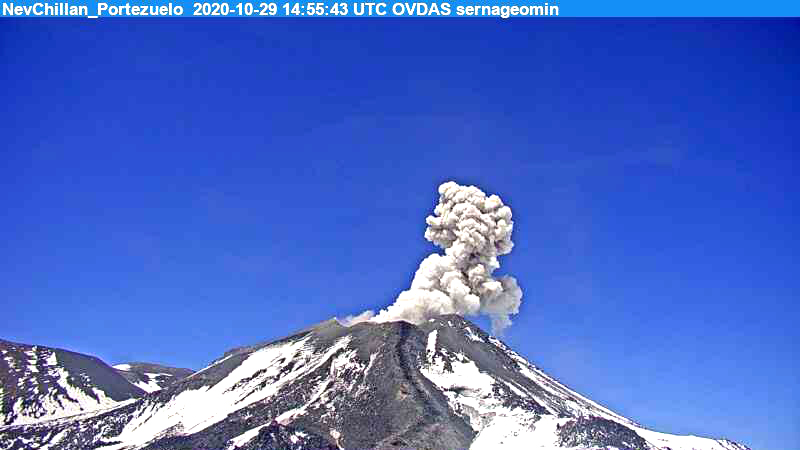 |
Figure 66. Webcam image of an explosion at Nevados de Chillán on 29 October 2020 that produced an ash plume that rose 360 m above the crater and drifted SW. Courtesy of SERNAGEOMIN. |
MIROVA (Middle InfraRed Observation of Volcanic Activity) analysis of MODIS satellite data shows frequent low-power thermal activity beginning in early June and continuing through October 2020 due to frequent explosions, the continued lava dome growth in Nicanor Crater, and the lava flow that descended the N flank (figure 67). On clear weather days, two thermal anomalies in the summit craters are observed in Sentinel-2 thermal satellite imagery; one represents the growing lava dome and the other is the lava flow on the N flank (figure 68). On 25 September an ash plume was observed drifting S.
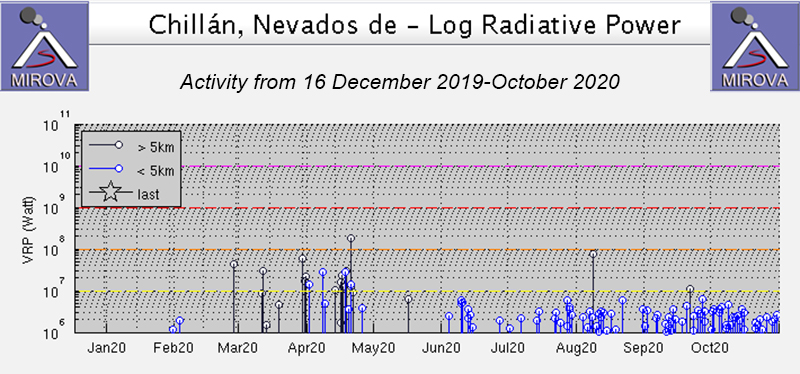 |
Figure 67. Frequent low-power thermal activity at Nevados de Chillán continued during July through October 2020, according to the MIROVA graph (Log Radiative Power). Courtesy of MIROVA. |
Geological Summary. The compound volcano of Nevados de Chillán is one of the most active of the Central Andes. Three late-Pleistocene to Holocene stratovolcanoes were constructed along a NNW-SSE line within three nested Pleistocene calderas, which produced ignimbrite sheets extending more than 100 km into the Central Depression of Chile. The dominantly andesitic Cerro Blanco (Volcán Nevado) stratovolcano is located at the NW end of the massif. Volcán Viejo (Volcán Chillán), which was the main active vent during the 17th-19th centuries, occupies the SE end. The Volcán Nuevo lava-dome complex formed during 1906-1945 on the NW flank of Viejo. The Volcán Arrau dome complex was then constructed on the SE side of Volcán Nuevo between 1973 and 1986, and eventually exceeded its height. Smaller domes or cones are present in the 5-km valley between the two major edifices.
Information Contacts: Servicio Nacional de Geología y Minería (SERNAGEOMIN), Observatorio Volcanológico de Los Andes del Sur (OVDAS), Avda Sta María No. 0104, Santiago, Chile (URL: http://www.sernageomin.cl/); Buenos Aires Volcanic Ash Advisory Center (VAAC), Servicio Meteorológico Nacional-Fuerza Aérea Argentina, 25 de mayo 658, Buenos Aires, Argentina (URL: http://www.smn.gov.ar/vaac/buenosaires/inicio.php); MIROVA (Middle InfraRed Observation of Volcanic Activity), a collaborative project between the Universities of Turin and Florence (Italy) supported by the Centre for Volcanic Risk of the Italian Civil Protection Department (URL: http://www.mirovaweb.it/); Sentinel Hub Playground (URL: https://www.sentinel-hub.com/explore/sentinel-playground); Volcanology Chile (URL: https://twitter.com/volcanologiachl); Jose Fauna, Caracol sector, San Fabián de Alicom, Chile (URL: https://twitter.com/josefauna).


